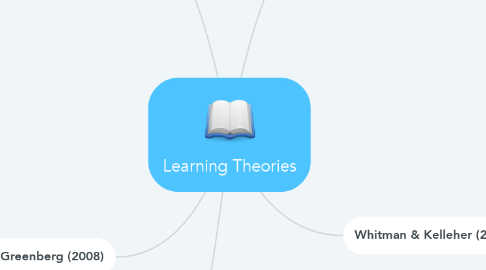
1. Senge (2012)
1.1. The Deep Learning Cycle
1.1.1. Learning occurs when the three domains are reinforce.
1.1.1.1. Awareness and sensibilities
1.1.1.2. Attitudes and beliefs
1.1.1.3. Skills and capabilities
1.1.2. Those involved at any level can provide tangible support by using the domain of action.
1.1.2.1. Articulate guiding ideas
1.1.2.2. Innovation in infrastructure
1.1.2.3. Theory, methods, and tools about building human competences
2. Keller (2009)
2.1. ARCS Model of Motivational Design
2.1.1. The ARCS Model is used to demonstrate the value of learning, and sustain the motivation to learn.
2.1.1.1. Attention
2.1.1.1.1. Active participation
2.1.1.1.2. Variability
2.1.1.1.3. Incongruity and Conflict
2.1.1.1.4. Specific examples
2.1.1.1.5. Inquiry
2.1.1.2. Relevance
2.1.1.2.1. Experience
2.1.1.2.2. Present Worth
2.1.1.2.3. Future Usefulness
2.1.1.2.4. Needs Matching
2.1.1.2.5. Modeling
2.1.1.3. Confidence
2.1.1.3.1. Grow the Learners
2.1.1.3.2. Feedback
2.1.1.3.3. Learner Control
2.1.1.4. Satisfaction
2.1.1.4.1. Feedback and reinforcement
2.1.1.4.2. Rewards and praise
2.1.2. When designing instruction it is important to keep ARCS mind build and find opportunities incorporate into learning medium.
2.1.2.1. There are strategies that can be employed to engage learners in eacharea.
3. Whitman & Kelleher (2016)
3.1. Memory + Attention + Engagement= Learning
3.1.1. Learning is currently set up to have students regurgitate information, and the information is lost shortly after. "Errorful" learning is the most effective way to create environment.
3.1.1.1. Memory
3.1.1.1.1. The Primacy Recency Effect
3.1.1.1.2. Arts Intergration
3.1.1.2. Attention
3.1.1.2.1. The flow of information entering the brain.
3.1.1.2.2. Reduce sensitivity to distracting information
3.1.1.2.3. Increase sensitivity to important information
3.1.1.3. Engagement
3.1.1.3.1. Students feel heard
3.1.1.3.2. Meaning, relevancy, or emotional connection to curriculum
3.1.1.3.3. Active work
3.1.1.3.4. Share specific learning outcomes
3.1.1.3.5. Aesthetic stimulation
3.1.1.3.6. Varied modalities
3.1.1.3.7. Provide scaffold feedback
3.1.2. To foster ongoing learning (beyond just memorization) errorful strategies must be employed.
3.1.2.1. Spacing
3.1.2.2. Interleaving
3.1.2.3. testing
4. Ackoff & Greenberg (2008)
4.1. The Five classes of the Human Mind
4.1.1. An ounce one class is worth a pound of the next class, therefore each class feeds into the next. Along the way learners develop description, instruction, retrospective and prospective reasoning, and eventually efficiency and effectiveness.
4.1.1.1. Data
4.1.1.2. Information
4.1.1.3. Knowledge
4.1.1.4. Understanding
4.1.1.5. Wisdom
4.1.2. This eventually leads to the development of values and judgement.
4.1.2.1. Learners exercise these skills through everyday experiences.
